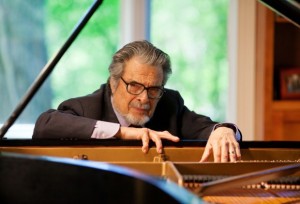
Pianist Leon Fleisher eventually recovered from focal dystonia after receiving a series of Botox injections.
In “Focal Dystonia in Musicians, Part 1,” we introduced focal dystonia and discussed its symptoms and possible causes. Now we return to present the treatment options for musicians suffering from this disorder.
Treating Focal Dystonia in Musicians
While the manifestation of focal dystonia and its impact on professional musicians are finally being addressed in the literature, it is still one of the most difficult disorders to treat. Many of the available treatments and therapies have low rates of success, and can take a number of years to complete. Dr. Alice Brandfonbrener, one of the founders of the field of Performing Arts Medicine, describes it as “an essentially untreatable and career-ending, or greatly-modifying, disease.” [1] Musicians with focal dystonia are often misdiagnosed by standard medical professionals, and must visit a clinic specifically for performing artists to receive proper treatment. Even then, it can take years of therapy to ease the patient onto the road of recovery.
Some of the more common treatments include Botulinum Toxin (Botox) injections, ergonomic adjustments, technical and pedagogical retraining, and neuromuscular rehabilitation. Injections of Botox may be used to temporarily decrease symptoms and help the patient regain the use of the affected body part long enough to complete a performance, but the dosage must be carefully regulated, and periodic, repeated injections are necessary, in order to be successful. [2] The recovery of Leon Fleisher from focal dystonia, following treatment using Botox injections, is one of the most highly publicized cases of the successful use of this treatment method, for focal dystonia in musicians.
Ergonomical modifications to the musician’s setup, such as support straps, finger splints, and individualized chin and shoulder rests, tend to alleviate symptoms and reduce some of the tension that initially triggered the dystonia, but these alone are not enough to cure it. Many musicians are forced to methodically re-learn their technique or “trick” their body with new positioning or adaptations, in a manner that will not elicit the same behavioral responses. [2] [3]
One of the most successful treatments–in conjunction with ergonomical adjustments–involves pedagogical and technical retraining, in which the patient slowly re-works his technique at a tempo that does not awaken his typical dystonic response. This method has proven useful in a number of different studies. [2] [4] [5] With the assistance of a knowledgeable teacher or somatic instructor, the patient’s awareness can be drawn to different aspects of his playing, so that he becomes more attuned to how he plays. Technical exercises, in moderation, can also be useful, because they give the patient an opportunity to examine his own playing technique in action and make necessary, minor adjustments to reduce tension. In a study by Jabusch & Altenmüller, this particular method of technical retraining was the only method found to alleviate symptoms of patients with embouchure dystonia, a specific type of dystonia found in wind and brass players. [2]
Stay tuned for “Focal Dystonia in Musicians, Part 3,” which will discuss strategies for prevention of this disorder.
References
[1] Brandfonbrener, A.G. (1995). Musicians with focal dystonia: a report of 58 cases seen during a ten-year period at a Performing Arts Medicine clinic. Medical Problems of Performing Artists, 10(4), 121-127.
[2] Jabusch H-C, & Altenmüller, E. (2006). Focal dystonia in musicians: from phenomenology to therapy. Advanced Cognitive Psychology, 2(2-3), 207-220.
[3] Horvath, J. (2002). Playing (less) Hurt. Kearney, NE: Morris Publishing.
[4] Sakai, N. (2006). Slow-down exercise for the treatment of focal hand dystonia in pianists. Medical Problems of Performing Artists, 21(1), 25-28.
[5] Tubiana, R. (2003). Prolonged neuromuscular rehabilitation for musician’s focal dystonia. Medical Problems of Performing Artists, 18(4), 166-169.














Good to see this subject recognised more in articles such as this. As a professional violinist and professional complimentary therapist in the UK I work with many musicians and focal dystonia is one area I specialise in. I agree that technical retraining is an important part of gaining recovery and I also focus very much on the emotional issues behind this problem.
In my experience the emotions behind focal dystonia have to be addressed to implement satisfactory recovery on a long term basis and using a holistic approach of muscular, technical and emotional retraining it is possible to achieve a successful outcome in many cases.
The internalised messages of fear, lack of confidence and the messages that have slipped into our unconscious beneath our awareness can have a disastrous effect on what we are trying to technically and musically achieve. If your unconscious message is to play the violin you have to hit your fingers down hard on the fingerboard or that you do not deserve to play to a professional standard your body will either break down or sabotage your own efforts but you will not know why.
Great website with lots of interesting articles. Thankyou.
very informative, thank you for posting such a good article
Nice articles! thanks for sharing..
Regards, Unissula